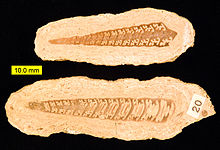Oncolite


Oncolites are sedimentary structures composed of oncoids, which are layered structures formed by the growth of one or more species of microorganisms,[1] usually containing cyanobacteria.[2] Oncolites are very similar to stromatolites, but, instead of forming columns, they form approximately spherical structures.[3] The oncoids often form around a central nucleus, such as a shell fragment,[4] and a calcium carbonate structure is deposited by encrusting microbes. Oncolites are indicators of warm waters in the photic zone, but are also known in contemporary freshwater environments.[5] These structures rarely exceed 10 cm in diameter.
Oncolites may have either a porostromate or spongiostromate texture. Most oncolites are spongiostromate, having no recognisable cellular texture or microstructure. Porostromate oncolites are mostly unknown during the Precambrian; since the Eocene they have mostly been confined to freshwater environments.[6]
Distribution
[edit]The appearance of recent or near-recent freshwater oncoids has been documented in two rivers in Bavaria: the Alz, whose source is the Chiemsee, and the Moosach, near Freising.[7][8][9] Modern oncoids also grow in some springs in Atacama Desert in South America. In one particular case a system of oncoids have been observed interface between Salar de Antofalla and an adjacent wetland.[10]
References
[edit]- ^ Zafar, Tehseen; Frontalini, Fabrizio; Rehman, Hafiz Ur; Khan, Danish; Ullah, Zaheen; Rahim, Hamad ur; Oyebamiji, Abiola; Hussain, Zahid; Song, Shuguang; Farhan, Muhammad; Ahmed, Mohamed S.; Sami, Mabrouk; Fathy, Douaa (June 2024). "Understanding the origin of Cambrian marine oncoids: A petrologic, geochemical, and isotopic perspective". Sedimentary Geology. 466: 106638. Bibcode:2024SedG..46606638Z. doi:10.1016/j.sedgeo.2024.106638.
- ^ Hägele, Daniela; Leinfelder, Reinhold; Grau, Jürke; Burmeister, Ernst-Gerhard; Struck, Ulrich (August 2006). "Oncoids from the river Alz (southern Germany): Tiny ecosystems in a phosphorus-limited environment". Palaeogeography, Palaeoclimatology, Palaeoecology. 237 (2–4): 378–395. Bibcode:2006PPP...237..378H. doi:10.1016/j.palaeo.2005.12.016.
- ^ Corsetti, Frank A.; Awramik, Stanley M.; Pierce, David (15 April 2003). "A complex microbiota from snowball Earth times: Microfossils from the Neoproterozoic Kingston Peak Formation, Death Valley, USA". Proceedings of the National Academy of Sciences. 100 (8): 4399–4404. Bibcode:2003PNAS..100.4399C. doi:10.1073/pnas.0730560100. PMC 153566. PMID 12682298.
- ^ Gutschick, R. C.; Perry, T. G. (1959). "Sappington (Kinderhookian) Sponges and Their Environment". Journal of Paleontology. 33 (6): 977–985. JSTOR 1300833.
- ^ Riding, Robert, ed. (1991). Calcareous Algae and Stromatolites. p. 32. doi:10.1007/978-3-642-52335-9. ISBN 978-3-642-52337-3.
- ^ Monty, C. L. (1981). "Spongiostromate vs. Porostromate Stromatolites and Oncolites". Phanerozoic Stromatolites. pp. 1–4. doi:10.1007/978-3-642-67913-1_1. ISBN 978-3-642-67915-5.
- ^ Hägele, Daniela (2007). Morphogenese, Wachstum und Ökologie der modernen Süßwasser-Onkoide der Alz (Thesis). Ludwig-Maximilians-Universität München. doi:10.5282/edoc.8314.
- ^ E. Rott (1994), "Der Algenaufwuchs in der Oberen Alz (Oberbayern)" (Online-Version; pdf-Datei; 7,6 MB), Berichte des Naturwissenschaftlich-medizinischen Vereins in Innsbruck (in German), vol. 81, Innsbruck, pp. 229–253
- ^ Arp, Gernot (2008). "Stop 7: Tufa oncoids of the river Moosach, Molasse Basin". In Reitner, Joachim; Quéric, Nadia-Valérie; Reich, Mike (eds.). Geobiology of Stromatolites: International Kalkowsky-Symposium, Göttingen, October 4-11, 2008 : Abstract Volume and Field Guide to Excursions (PDF). Universitätsverlag Göttingen. pp. 193–197. ISBN 978-3-940344-52-6.
- ^ Villafañe, Patricio Guillermo; Lencina, Agustina Inés; Soria, Mariana; Saona, Luis Alberto; Gómez, Fernando Javier; Alonso, Guido Ezequiel; Farias, María Eugenia (31 May 2021). "Las Quínoas oncoids: a new deposit of microbialites in the Salar de Antofalla (Catamarca, Argentina)". Andean Geology. 48 (2): 281. doi:10.5027/andgeoV48n2-3292. hdl:11336/148257.
